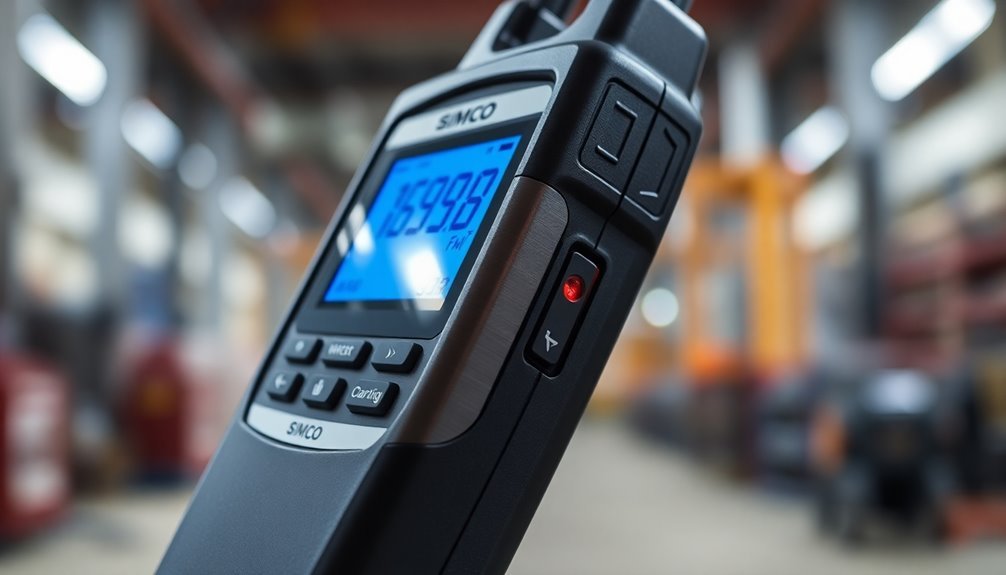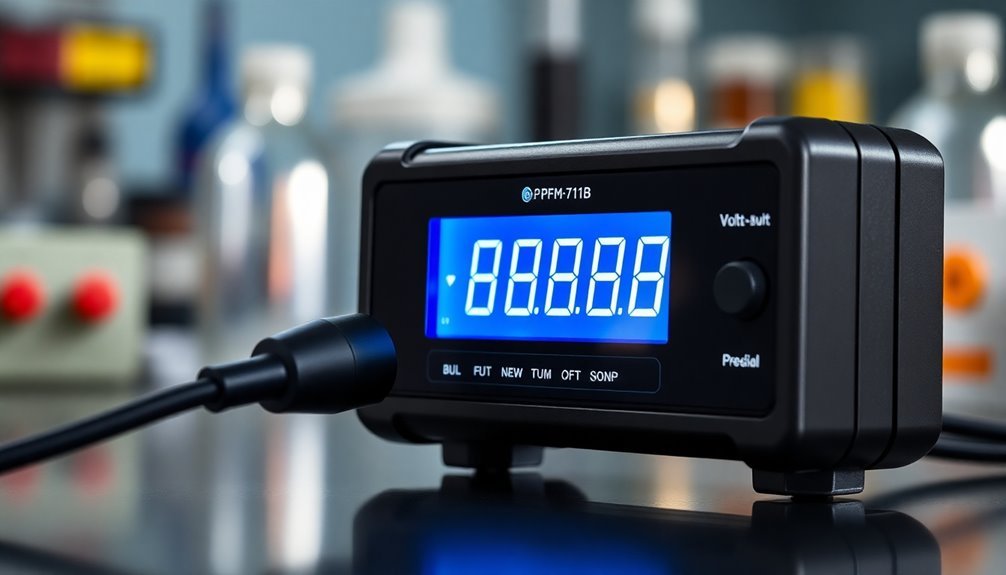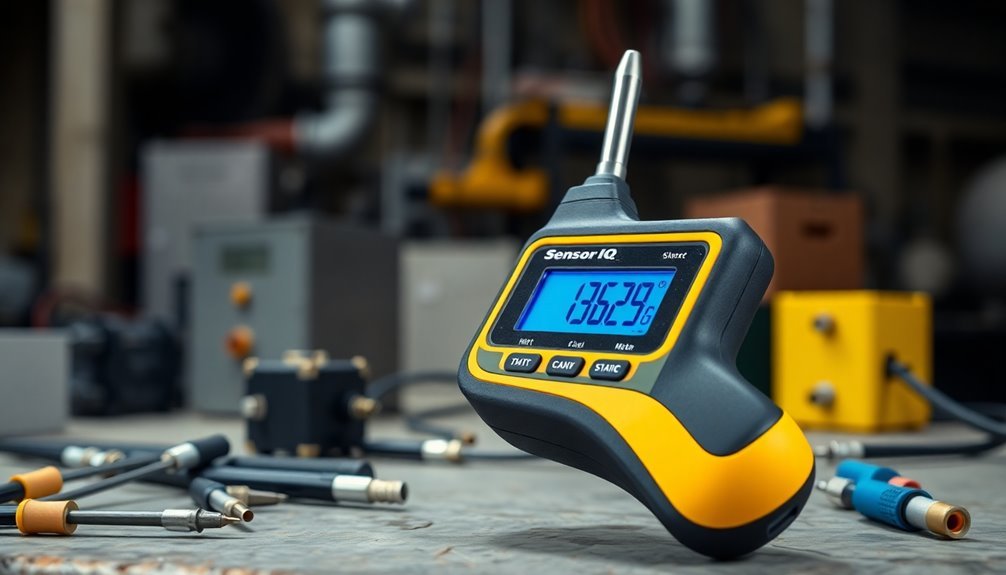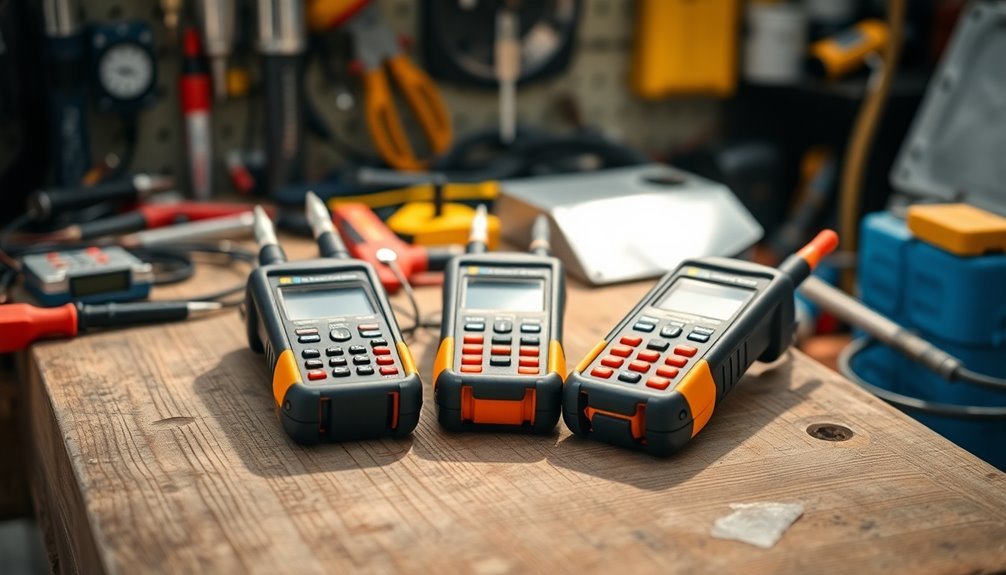The top portable field meters for static testing include the versatile Simco FMX-004 with its ±30 kV range, the ACL 450B offering precise measurements up to ±20,000V, and the Prostat PFM-711B featuring 10V increment accuracy. You'll find excellent options in the Haug Digital Static Meter measuring up to 200 kV, the Trek Model 520 with its ±2 kV DC capacity, the Monroe Model 257D with dual sensitivity ranges, and the Sensor IQ Easy for industrial applications. Each device offers unique features like LED positioning guides, data logging capabilities, and extended battery life. The specific details of these meters' capabilities might surprise you.
Simco FMX-004 Field Meter

When measuring static charges in the field, the Simco FMX-004 serves as a compact, handheld electrostatic meter that offers thorough measurement capabilities up to ±30 kV.
You'll find this lightweight device, weighing just 0.38 lb, fits comfortably in your hand at 4.8"L x 2.9"W x 1.0"D.
The meter's conductive ABS resin construction guarantees proper grounding, while two LED guide lights help you position the device exactly 1 inch from charged objects for accurate readings.
You can view measurements through both numerical displays and bar graphs, complete with color-coded polarity indicators. The LCD screen displays red for positive and blue for negative voltage readings.
You won't need to worry about battery life, as the 9V alkaline battery provides 30 hours of operation, and the auto-power-off feature activates after 5 minutes of inactivity.
The device responds quickly, delivering readings in less than one second with ±10% accuracy.
For continuous monitoring, you can connect the FMX-004 to a PLC or data logger using the optional cable kit.
The meter operates reliably in temperatures from 50-100°F and humidity levels up to 60% RH.
You'll also appreciate the audible alarm that alerts you to over-range measurements and low battery conditions.
ACL Digital Static Field Meter
Anyone seeking precise static charge measurements will appreciate the ACL 450B digital field meter. This pocket-sized device measures static charges from 0 to ±20,000v in 100v increments at 1" distance, displaying readings on a 3½-digit LCD screen with auto-polarity readout.
You'll get ±5% accuracy and immunity from ionizer interference thanks to its chopper stabilization feature.
The ACL 450B excels in various industrial applications. You can use it in electronic manufacturing to evaluate charge accumulation, or in converting, printing, and packaging operations. It's particularly effective in ionized environments where other meters might struggle. The meter's LED ranging lights help ensure precise distance positioning for accurate measurements.
The device's "HOLD" button lets you capture readings instantly, while the 2.5mm output jack enables analog data collection.
You'll find this CE-compliant meter practical for material production, quality control, and research applications. It runs on a standard 9-volt battery and comes with a traceable calibration certificate.
At just 2.4" x 4.2" x 0.9", you can easily carry it in your pocket while performing static surveys in textiles, packaging, or engineering labs.
Prostat PFM-711B Portable Meter

The Prostat PFM-711B field meter delivers dual-range precision for your static testing needs. You'll get accurate measurements from 0 to ±20,000 volts in 10-volt increments for high-range testing, and 0 to ±1,999 volts in 1-volt increments for low-range applications, all at a 1-inch distance. The meter's two-year warranty on circuit boards provides excellent coverage for long-term reliability.
The meter maintains ±5% accuracy across both ranges, while two red LEDs help you position it correctly.
You can operate this device with one hand, reading measurements from its 3.5-digit LCD display. The meter's conductive case serves as a ground reference, and you can ground it using either a wrist strap or worksurface snap.
You'll get about 30 hours of operation from a 9-volt alkaline battery, with a low battery indicator triggering at 7.2 volts.
The PFM-711B's chopper-stabilized sensor works effectively in ionized environments, and you can connect it to recording devices through its analog output. The ZERO, HOLD, and RANGE pushbuttons make operation straightforward.
While the meter requires initial stabilization and doesn't retain data when powered off, it's compatible with the PGA-710B Autoanalysis System for advanced documentation needs.
Haug Digital Static Meter
Similar to its counterpart, Haug's Digital Static Meter offers versatile measurement capabilities with expanded range options.
You'll get accurate readings from 0 to 200 kV, with five different measurement distances ranging from 1 cm to 20 cm. The device's integrated microcomputer automatically converts field strength into voltage readings, displaying them on a two-line LCD screen. The meter utilizes the fieldmill influence principle to generate alternating current proportional to electrical field strength.
You can rely on this meter for about 10 hours of continuous operation using a standard 9V battery. The unit's built-in voltage control will shut off automatically when the battery drops below 7.0 volts, preventing acid leakage and damage.
When you're taking measurements, you'll find the included 26mm spacers helpful for maintaining the precise 2 cm distance needed for accurate readings.
The meter's hold function lets you freeze measurements on the display, while its lightweight design (130g without battery) makes it ideal for prolonged use. You can operate it in temperatures from +5°C to +50°C, making it suitable for most industrial environments.
Whether you're working in electronics, pharmaceuticals, or plastics manufacturing, you'll appreciate its high measuring sensitivity and precise field strength measurements.
TREK Model 520 Electrostatic

You'll find the TREK Model 520 Electrostatic meter offers advanced field measurement capabilities with its ±2 kV DC range and better than ±5% accuracy across recommended probe distances.
The unit's real-time data logging capabilities, particularly in the 520-2 version, let you record measurements directly through the analog output for detailed analysis.
The meter's 8-hour battery life ensures reliable extended operation during lengthy testing sessions. The compact, portable design with digital display gives you instant voltage readings without requiring fixed spacing, making it practical for various industrial testing environments.
Advanced Field Measurement Features
Featuring state-of-the-art measurement capabilities, TREK's Model 520 Electrostatic field meter offers an extensive range of advanced features for precise static testing.
You'll find impressive accuracy within ±5% of full scale when measuring voltages up to ±2 kV DC, with a swift response time under 25 ms. The meter's spacing independence guarantees reliable readings between 5-25 mm from the surface, while its stability maintains minimal drift of less than 600 ppm per hour. The 47 Ω output impedance ensures optimal signal quality for measurement applications.
You can choose between two versatile models: the 520-1 with digital display or the 520-2 with additional analog output for detailed waveform analysis. The device's compact dimensions of 31 x 59 x 173 mm make it perfect for handheld operation, powered by a single 9V battery lasting up to 8 hours.
- Quick measurements at 2.5 readings per second through non-contacting technology
- Clear visibility with 3½ digit LED display showing 0 to ±1999 V
- One-touch hold function for capturing specific readings
- NIST-traceable certification guaranteeing measurement reliability
The meter excels in various applications, from manufacturing processes to ESD auditing, making it an essential tool for electronic assembly and semiconductor testing environments.
Real-Time Data Logging
Real-time data logging reaches new heights with the TREK Model 520-2's advanced monitoring capabilities. You'll get highly accurate measurements within ±5% of full scale, backed by a NIST-traceable Certificate of Calibration. The voltage display accuracy of ±0.5% guarantees you're getting reliable readings every time.
You can capture rapid voltage changes with the meter's impressive response time of less than 25ms for 0 to ±2 kV input steps. The Model 523 offers 2.5 readings per second, making it perfect for dynamic ESD testing environments. The recommended spacing range of 5mm to 25mm ensures consistent measurement accuracy.
Through the 1.3mm analog output jack (Model 520-2), you'll be able to monitor measurements in real-time with a 1/1000th voltage ratio.
You're able to connect directly to oscilloscopes or data acquisition systems through the 47Ω output impedance, making it ideal for continuous monitoring and analysis. Whether you're testing in ionized or non-ionized environments, you can effectively measure electrostatic surface charge build-up, analyze manufacturing processes, or conduct electronic assembly testing.
The non-contacting measurement method and hand-held design let you easily perform ESD audits and troubleshooting while maintaining mobility throughout your facility.
Compact Portable Design
The TREK Model 520's lightweight design puts professional-grade static testing right in your hands. You'll appreciate its non-contacting measurement capability, which lets you take accurate readings without maintaining a fixed distance from the surface. The recommended probe-to-surface spacing of 5 to 25mm gives you plenty of flexibility while maintaining ±5% accuracy across the full ±2 kV DC range.
The red and blue LCD displays make it easy to identify positive and negative charges at a glance. The compact design excels in various testing environments, where you'll need to:
- Navigate tight spaces between electronic components during assembly line inspections
- Move quickly across multiple test points in semiconductor facilities
- Carry the device comfortably during extended ESD auditing sessions
- Access hard-to-reach surfaces in automotive electronics testing
If you're using the 520-2 version, you'll have both digital display readings and analog output monitoring at your disposal.
The chopper-stabilized design guarantees you'll get drift-free operation in ionized environments, while the quick 25ms response time means you won't miss sudden voltage changes.
Whether you're conducting routine ESD audits or troubleshooting dissipative materials, the Trek 520's portable design makes professional static testing accessible wherever you need it.
Monroe Model 257D Fieldmeter
You'll find the Monroe Model 257D Fieldmeter packs impressive features into its portable 2.4-pound frame, including dual power options and a remote probe for accessing hard-to-reach areas.
The unit's measurement capabilities span two ranges of ±2kV/cm and ±20kV/cm, letting you handle various testing scenarios with confidence.
The fieldmeter's drift-free measurement system guarantees accurate readings in ionized environments, while its non-contact measurement capability makes it ideal for production line surveys and static-free workstation monitoring.
Key Features and Specifications
Measuring static charges in the field demands reliable instrumentation, and the Monroe Model 257D Fieldmeter delivers essential features for portable testing.
You'll get over 8 hours of continuous operation with the built-in rechargeable battery, and the quick 6-hour recharge time guarantees minimal downtime. At just 2.6 pounds, you can easily carry this compact unit to various testing locations.
The 1036F-5 probe connects directly to the instrument's rear panel through a DB-9 connector, and you can extend its reach up to 1,000 feet with an optional cable. You'll need to mount the probe 1 cm from your test material for ideal readings.
- Chopper-stabilized design cuts through ionized environments for precise measurements
- Built-in purging system keeps the unit drift-free in hazardous locations
- Recorder output enables unattended monitoring of static charges
- Analog output provides ±1.0V for every ±10kV/m measured
The unit's versatile power options include worldwide AC compatibility (100-240VAC), while its robust operating range (-30°C to +100°C) guarantees reliability across diverse environments. Factory Mutual approval certifies its intrinsic safety for hazardous location testing.
Measurement Range and Accuracy
Two versatile measurement ranges make the Monroe Model 257D Fieldmeter adaptable for diverse testing needs: ±2kV/cm and ±20kV/cm, with standard sensitivities of 1V/m and 10V/m respectively.
You'll find additional flexibility with optional probe ranges including ±10kV/inch, ±1kV/cm, ±10kV/cm, and ±1kV/inch, allowing you to choose the most suitable range for your specific application.
You can rely on the Model 257D's impressive accuracy specifications. It delivers static accuracy better than 5% of reading, while maintaining a drift of less than 30V/m/hour (non-cumulative after 30 minutes stabilization).
The noise level stays below 10V/m rms in the 0-200 Hz range, and you'll get a quick response speed of 250 ms from 10% to 90%.
The analog output provides precise readings with ±10kV/m equaling ±1.0V output at less than 10 ohm impedance.
Your probe will function reliably across a wide temperature range from -30°C to 100°C in non-condensing conditions.
For peak performance, you'll need to guarantee annual recalibration, especially after any repairs or tampering, to maintain the meter's accuracy and reliability.
Sensor IQ Easy Static Meter

Modern static monitoring achieves new heights with the Sensor IQ Easy Static Meter, a bar-type device that accommodates up to 16 sensor heads for thorough web charge detection.
You'll find this system offers real-time control through closed-loop feedback, allowing you to monitor and adjust static charge levels instantly. The device's fiberglass reinforced plastic construction prevents deflection while maintaining IP66 protection for industrial environments.
You can connect the Sensor IQ Easy directly to the Manager IQ Easy, which stores and processes your measurement data. With its standard Ethernet port, you'll easily retrieve information for quality control and process monitoring.
The system's compressed air connection keeps sensor orifices clean, ensuring consistent performance in demanding industrial settings.
- Strategically position up to 16 sensor heads across your web width
- Monitor live charge readings through the central Manager IQ Easy display
- Access stored data through the Ethernet connection for analysis
- Control static levels automatically through closed-loop feedback
The Sensor IQ Easy integrates seamlessly with other IQ platform devices, allowing you to connect up to six IQ devices to a single Manager IQ Easy for extensive static control management.
Frequently Asked Questions
How Often Should Portable Field Meters Be Recalibrated?
You'll need to calibrate your conductivity, pH, and dissolved oxygen meters daily before use. Check your ORP sensor regularly, though it may hold calibration for several days. All sensors require verification when used.
Can Portable Field Meters Be Used in Explosive Environments?
Yes, you can use portable field meters in explosive environments, but you'll need specifically certified intrinsically safe or explosion-proof models that match your zone's requirements (Zone 1 or 2) and have proper safety certifications.
What Happens if the Grounding Connection Fails During Measurement?
If your grounding connection fails, you'll get inaccurate readings and risk electrical shock. Your meter won't measure electrostatic fields correctly, and you'll need to stop testing until you've restored proper grounding.
Do Temperature and Humidity Affect Field Meter Readings?
Yes, they'll affect your readings substantially. Temperature changes can impact electronic components and sensor accuracy, while humidity can cause condensation and corrosion. You'll need proper calibration and environmental controls for reliable measurements.
How Long Does Field Meter Sensor Technology Typically Last Before Replacement?
You'll need to replace your field meter sensors at different intervals: electrochemical ones last 2 years, catalytic sensors 5 years, NDIR/infrared 7-8 years, and soil moisture sensors can last 3-10+ years with proper maintenance.
In Summary
You'll find these seven portable field meters offer reliable static testing solutions for your various measurement needs. Whether you're choosing the popular Simco FMX-004, the precise ACL Digital, or any other model from this curated list, you're getting industry-tested equipment. Consider your specific requirements for accuracy, ease of use, and budget when selecting the right static meter for your applications.





Leave a Reply